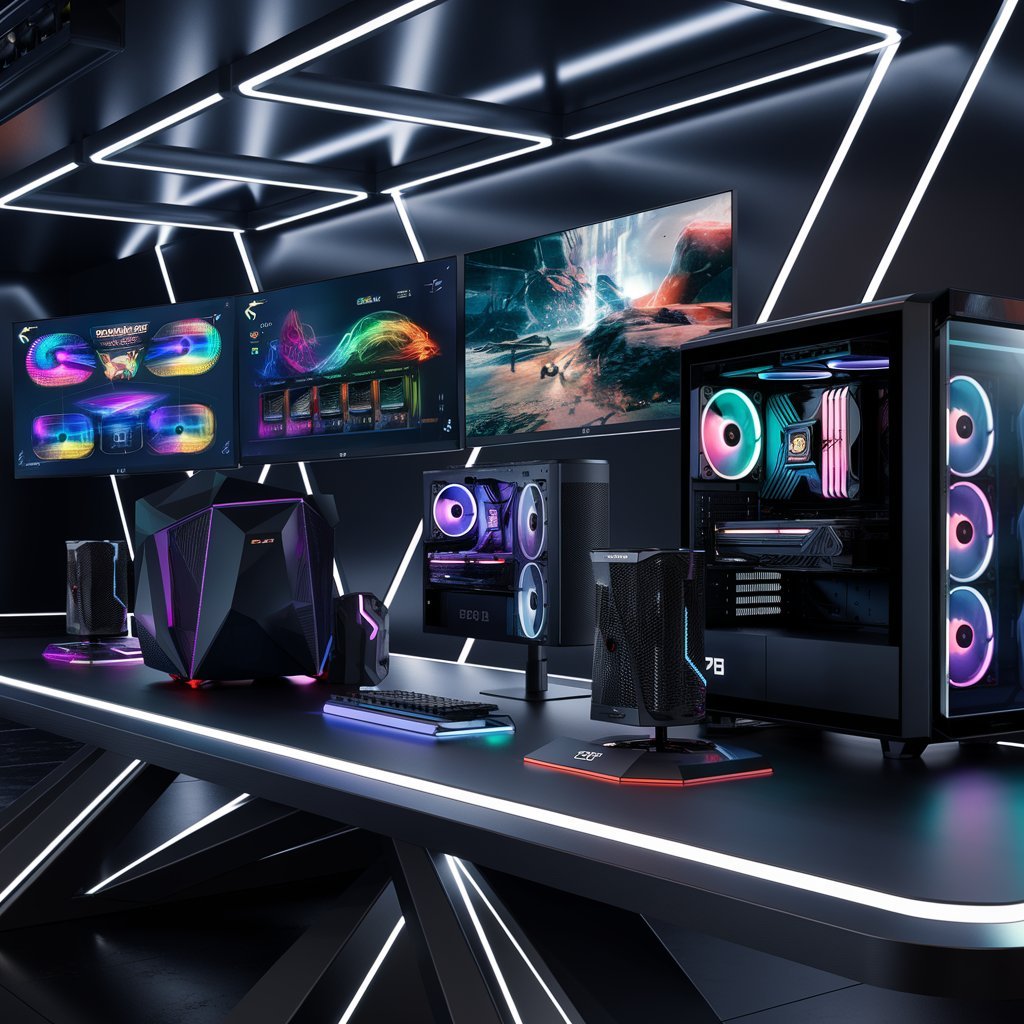In the fast-paced world of gaming, performance is everything. High-end gaming PCs offer power, speed, and graphics capabilities that can elevate your gaming experience to an entirely new level. However, choosing the right one can be a daunting task with so many specifications and features to consider. In this comprehensive guide, we will explore the key elements in benchmarking and comparing high-end gaming PCs, helping you make an informed decision when investing in your ultimate gaming setup.
Why Benchmarking Matters
Benchmarking is running standardized tests on a gaming PC to measure its performance in various areas such as processing power, graphics rendering, and system efficiency. By doing this, you can directly compare different systems or configurations and understand how well a gaming PC can handle resource-intensive games. Benchmarking helps users determine the true performance capabilities of a system and whether or not it meets their needs.
Key Components to Benchmark in a Gaming PC
1. Central Processing Unit (CPU)
The CPU is the heart of any gaming PC, and it handles most of the system’s computations. When comparing high-end gaming PCs, it’s crucial to look at the performance of the CPU under load. Popular processors for high-end gaming include the Intel Core i9 series and AMD Ryzen 9 series.
Benchmarking tools like Cinebench and Geekbench tend to measure multi-core and single-core CPU performance. Key metrics include clock speed (measured in GHz), core count, and overall stability under gaming loads. High-end CPUs should have fast clock speeds, ample cores, and managing tasks.
2. Graphics Processing Unit (GPU)
The GPU is perhaps the most important component for gaming. It handles all the graphical computations and is responsible for rendering stunning visuals at high frame rates. NVIDIA’s GeForce RTX 30 series and AMD’s Radeon RX 6000 series are some of the top contenders in the high-end GPU market.
GPU benchmarks are often tested using software such as 3DMark, Unigine Heaven, and FurMark. These tools stress the GPU to simulate real-world gaming scenarios and measure its ability to handle complex graphics and maintain stable frame rates. Benchmarks usually report frame rates (fps), thermal performance, and power consumption.
3. Random Access Memory (RAM)
RAM is essential in ensuring smooth gaming performance, especially in multi-tasking and loading games with large assets. High-end gaming PCs usually come with 16GB or 32GB of RAM, though some extreme setups may feature up to 64 GB.
Benchmarking tools like AIDA64 or PassMark’s RAM test measure the bandwidth, latency, and speed of the memory. These factors determine how quickly the system can access game data and process information, resulting in shorter load times and fewer performance bottlenecks.
4. Storage (SSD vs. HDD)
For gamers, having fast storage is essential for quick load times and seamless gameplay. Solid State Drives (SSDs) outperform traditional Hard Disk Drives (HDDs) in terms of speed and reliability. Most high-end gaming PCs today come with at least a 1TB SSD, often paired with additional HDD storage for larger files.
Benchmarking storage performance involves testing read and write speeds using software like CrystalDiskMark or ATTO Disk Benchmark. The faster the SSD, the quicker the system can load and save data, leading to a more responsive gaming experience.
5. Cooling Systems
Heat management is critical in high-end gaming PCs. Overheating can lead to reduced performance and, in severe cases, hardware damage. Most high-end gaming setups come with sophisticated cooling systems, including liquid cooling or advanced air cooling solutions.
Benchmarking the cooling system’s efficiency typically involves stress testing the CPU and GPU while monitoring temperatures with software like HWMonitor or MSI Afterburner. A good cooling system will maintain optimal temperatures under heavy loads, ensuring consistent performance.
6. Power Supply Unit (PSU)
A high-end gaming PC requires a reliable and efficient PSU to power all components. The PSU must deliver adequate wattage to prevent crashes or instability during gaming. High-end PSUs often feature certifications such as 80 PLUS Gold or Platinum, indicating energy efficiency.
Comparing High-End Gaming PCs: Key Metrics
1. Frame Rate (FPS)
Frame rate is one of the most critical metrics in gaming PC benchmarking. Measured in frames per second (fps), it indicates how smoothly a game runs. A higher frame rate results in a smoother gaming experience. Most high-end gaming PCs should achieve at least 60fps in demanding games at high settings, with some setups reaching 144fps or even higher in competitive titles.
2. Resolution and Graphics Settings
The ability of a gaming PC to handle high-resolution gaming is another crucial comparison point. Most modern systems can play games at 1440p or 4K resolution, with varying levels of detail (e.g., medium, high, ultra). Benchmarking results will show how a PC performs across different resolutions and settings.
3. Thermal Performance
Comparing how different gaming PCs manage heat is essential, especially for gamers who push their systems with extended gaming sessions. Look for benchmark results that show average and maximum temperatures for both CPU and GPU under load. Cooler systems typically offer better long-term performance and reliability.
4. Overclocking Potential
Some gaming PCs come with components that are designed to be overclocked, allowing for higher performance at the cost of increased power consumption and heat. Overclocking benchmarks will show how much headroom there is for boosting the CPU or GPU, and how well the system can handle the extra heat generated during overclocking.
5. Input/Output Ports and Connectivity
Another important comparison metric for high-end gaming PCs is the availability of I/O ports and wireless connectivity options. Modern gaming setups typically come with multiple USB ports, HDMI, DisplayPort, Ethernet, and sometimes Thunderbolt connectivity. Benchmark tests don’t always focus on these features, but they are essential for peripherals like gaming monitors, VR headsets, or controllers.
Top High-End Gaming PCs to Consider in 2024
1. Alienware Aurora R15
The Alienware Aurora R15 is a beast when it comes to high-end gaming, featuring Intel Core i9-13900K processors and NVIDIA GeForce RTX 4090 GPUs. It delivers top-tier performance, supporting 4K gaming at ultra settings and high frame rates. Its advanced cooling system ensures PC stays cool even during marathon gaming sessions.
2. MSI MEG Trident X
A compact yet powerful gaming PC, the MSI MEG Trident X is equipped with Intel i9 processors and NVIDIA RTX 30 series GPUs. It offers exceptional gaming performance, sleek design, and effective cooling for sustained high-end gaming. Its benchmarking results show it can handle most AAA games at 1440p or 4K resolutions.
3. Corsair Vengeance i7200
Corsair’s Vengeance i7200 comes packed with Intel Core i9 and AMD Ryzen 9 options, coupled with high-performance RTX 30 series GPUs. Its solid overclocking capabilities and excellent cooling make it a standout choice for gamers who want to push their system to the limit.
Conclusion
Benchmarking and comparing high-end gaming PCs involves analyzing components such as the CPU, GPU, RAM, storage, and cooling system. It is crucial to consider key metrics like frame rate, resolution, and thermal performance to determine which gaming PC offers the best performance for your needs. With this comprehensive guide, you’ll be well-equipped to decide on your next high-end gaming PC purchase. Whether you’re a casual gamer or an esports enthusiast, finding the right PC will elevate your gaming experience.





